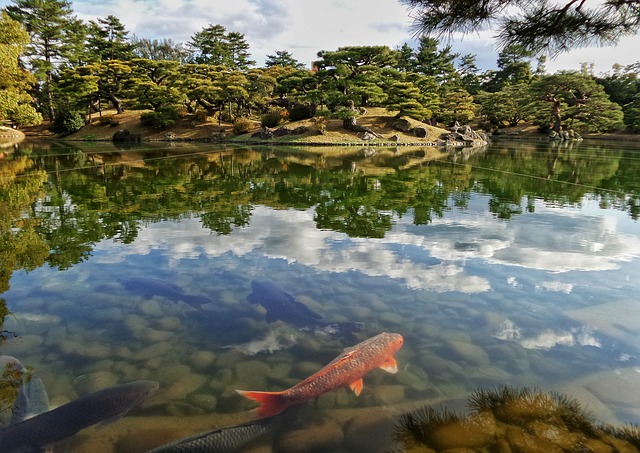Are you looking to build a pond in your garden and want to fill it with koi or do you have a small fish tank in your living room that you’re looking to stock? Either way, it’s important that you know the differences in your options.
Their Size & Cost
You probably already know that koi carp are not the right fish to slip into that small indoor tank, but what are the other distinct differences between the two types of fish?

There are plenty of arguments as to whether keeping goldfish is an easier care job, but the truth is it will be wholly dependent on the habitat you will be keeping your fish in. If your plan is to create that water garden pond in your yard, then bear in mind that Koi are more likely to uproot plant life, knock plants around, and they might even eat them. Whereas goldfish are just happy to dart around your chosen foliage.
So, the biggest differences between the two fish are their size and cost. Koi grow to be very large so it’s imperative that you have an appropriate space for them. If your pond is going to be relatively small then goldfish is the wiser option. Especially because koi is the pricier of the fish. An average koi can cost around $50, however, if you’re looking to stock your pond with colorful koi with elaborate patterns you can expect to spend at least hundreds, if not thousands.
As beautiful as they are goldfish are suited to the average back yard, especially for someone who is new to collecting and caring for fish. This is especially true if you’re not looking to spend too much time or money on the hobby. There’s good news, though, because goldfish can be beautiful and colorful, too, with them coming in an assortment of types.
The Commitment
Koi can happily survive even the chilliest of winters, provided your pond is a minimum of two feet deep, however, your goldfish will need to be brought indoors for the chilly weather.

It doesn’t matter what type of fish you choose, they will both live for quite some time when cared for properly. How long? You can expect your goldfish to live for at least 10 years, up to 20 years, and if you take extra good care of it know that the oldest ever goldfish was 43 years old when it passed. As for koi? The average lifespan is 50 years, but the oldest one? Well, it was over 200, so you might want to include it in your will. Koi actually get larger as they age, and can hit up to three-feet long. However, a goldfish’s growth will be restricted to the environment you provide for it. So, if you choose a small bowl for one simple goldfish it will remain fairly small, but if you provide it with a pond it could grow to be a foot-long.
If you don’t know which to choose there’s good news, they are happy to live together!
The Big Differences
You have probably seen large fish swimming around an outdoor and misidentified them. A big fish is just a big fish, right? Well, in truth goldfish and koi are related, but distantly. The biggest differences between the two are their body structure and patterns.
There are different varieties of each and for koi, you will find that they are named for their color patterns. Here are some of the common types.
Ogon is a solid colored koi.
Kohaku koi is white with patterns of red.
Bekko is a solid color but has black spots.
The Sanke koi is white with splashes of red as well as a black pattern that resembles stepping stones.
Showa is white, black, and red with a pattern that all works together.
There are also different types of goldfish and the most common ones include:
The Sarassa which has patterns of red and white.
The calico colored Shubunkin has a tint of blue as well as black and red spots.
There is also the common solid colored goldfish which come in orange, black, yellow, brown, and red.
Then there’s the body structure.
If you take a closer look at the koi you will find that it has whiskers like catfish, it’s tapered at either end, has a pointy nose, and a flat belly. They may have long fins (butterfly) or be well defined (standard). As for the placement and quantity of scales, this will vary from koi to koi.
Goldfish have noses that are blunt and rounded. They may have fantails or butterfly fins. Their scales are located all over and well distributed.
Before you go and stock up on all the fish necessities, check out OZCodes for awesome discount codes and vouchers.

